Reptiles and Amphibians
Media

Species Types
Scientific Name
Hemidactylium scutatum
Description
A glacial relict in Missouri’s eastern Ozarks, the four-toed salamander lives among mosses in heavily forested streams and creeks and sinkhole ponds. It has a thick, round tail that is constricted at its base. There are four toes on each limb.
Media
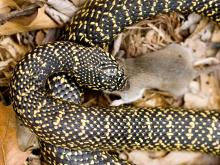
Species Types
Scientific Name
Lampropeltis holbrooki
Description
The speckled kingsnake is generally black, but a white or yellow spot in the center of most of the scales makes it look speckled. The belly is yellowish with some irregular black markings. A harmless, beneficial snake found nearly statewide.
Media
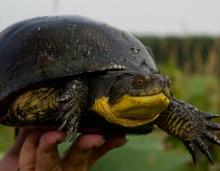
Species Types
Scientific Name
Emydoidea blandingii
Description
Blanding’s turtle has an oval, moderately high-domed upper shell and a long head and neck. This turtle is endangered in Missouri and occurs only in the extreme northern corners of the state.
Media
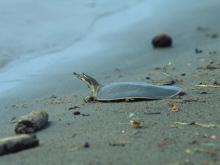
Species Types
Scientific Name
Apalone mutica mutica
Description
The midland smooth softshell is a rather plain-looking softshell turtle, with a smooth, rather featureless olive-gray or brown shell, and a light stripe bordered by black extending backward from each eye.
Media
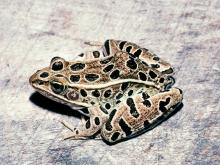
Species Types
Scientific Name
Lithobates pipiens
Description
The northern leopard frog is a medium-sized frog with dark spots on the back. Two skin folds run down each side of the back. In Missouri, it only occurs in a few northwestern counties along the Iowa border.
Media
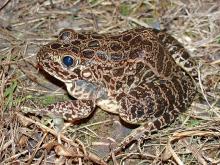
Species Types
Scientific Name
Lithobates areolatus circulosus
Description
A very secretive species, the northern crawfish frog spends most of its time hidden burrows, typically those made by crayfish. It is restricted to native prairie or former prairie areas and is a species of conservation concern in Missouri.
Media
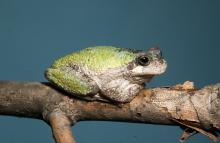
Species Types
Scientific Name
Hyla versicolor (Gray Treefrog) and Hyla chrysoscelis (Cope's Gray Treefrog)
Description
Sticky pads on fingers and toes enable Missouri's two gray treefrogs to climb and rest on vertical surfaces. You might occasionally see one resting on the siding of your house, if you live near suitable treefrog habitat.
Media

Species Types
Scientific Name
Anaxyrus cognatus
Description
Unlike other true toads in Missouri, the Great Plains toad has a raised hump between the eyes on the snout. Look for it along the Missouri River floodplain, from the Iowa border to about Hermann.
Media
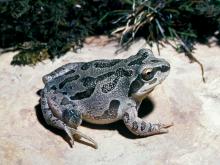
Species Types
Scientific Name
Pseudacris illinoensis
Description
With its stout body and thick forearms, the rare Illinois chorus frog may at first appear more like a toad. It lives in open, sandy areas that were formerly sand prairie grasslands and wetlands of southeastern Missouri.
Media

Species Types
Scientific Name
Aspidoscelis sexlineata viridis
Description
Prairie racerunners are fast, alert, ground-dwelling lizards. They live in open areas like fields, grasslands, and rocky, south-facing hillsides, including Ozark glades. They are related to the whiptail lizards that live in the western United States.
See Also
About Reptiles and Amphibians in Missouri
Missouri’s herptiles comprise 43 amphibians and 75 reptiles. Amphibians, including salamanders, toads, and frogs, are vertebrate animals that spend at least part of their life cycle in water. They usually have moist skin, lack scales or claws, and are ectothermal (cold-blooded), so they do not produce their own body heat the way birds and mammals do. Reptiles, including turtles, lizards, and snakes, are also vertebrates, and most are ectothermal, but unlike amphibians, reptiles have dry skin with scales, the ones with legs have claws, and they do not have to live part of their lives in water.





















